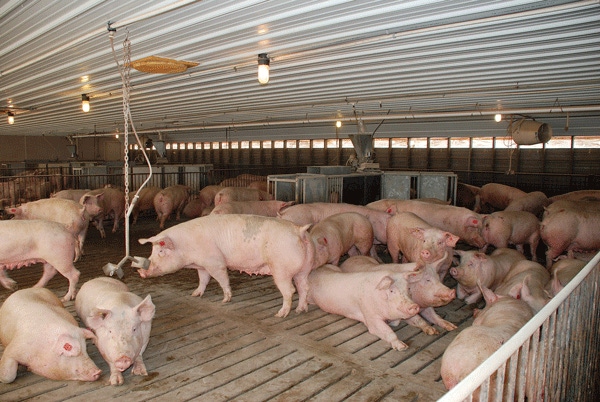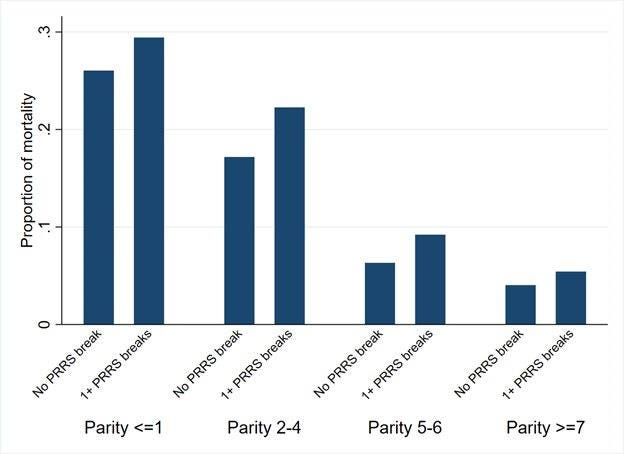Understanding sow mortality: Part 2
Explored are environmental, farm-level and individual-level factors possibly associated with sow mortality using different methodological approaches.
December 7, 2020

In part one of this article, we described sow mortality in four farms representative of current practices in the U.S. during almost a decade of study. Here, we will explore environmental, farm-level and individual-level factors possibly associated with sow mortality using different methodological approaches.
First, we calculated the percent of the sow herd that died in each of the 470 weeks studied considering the individual farms. We considered >0.175% weekly mortality (equivalent to 9.1% annualized mortality) as high mortality weeks. Factors such as maximum minimum temperature, daytime high temperature and nighttime low temperature during each week were obtained from the National Oceanic and Atmospheric Administration (NOAA) website corresponding to the nearest airport to each farm. Season, PRRS status, housing (individual vs. group), filtration, percentage of gilts and gestating animals in the inventory, labor allocation (average sow/hour/employee) and feed medication were also assessed. In the final model, only season and feed medication were associated with high mortality weeks. Similarly to what described in Part 1, we found that spring and summer weeks have 1.27 and 1.37 times the risk of having high mortality compared to winter weeks, respectively. Again, the higher probability of being a high mortality week during warmer weeks is likely related to factors aggravating thermal stress. We also found that weeks in which medication is implemented in the feed have 1.38 times the risk of being a high mortality week than when feed medication is not present. In this case, medication is likely acting as a proxy to the herd’s overall health meaning medication is being used as therapeutic treatment rather than prophylaxis.
Then, we looked at the sow’s individual risk of dying throughout the lifetime of the 70,467 individual animals studied. Even though mortality was higher among lower parity sows, when looking at each parity category, we found that mortality was always higher amongst sows that experienced at least one PRRS outbreak in their lifetime (Figure 1). This means that sows that have been exposed to at least one PRRS break during their lifetime had a mortality rate 1.55 times higher than those that were never exposed to a PRRS break when taking parity into account. That can be easily rationalized as the mortality risk increasing in the face of health challenges such as this infectious disease. Similarly, we also found that sows housed in filtered farms had 0.76 times the mortality rate of those in non-filtered farms, likely because these and other infectious health challenges are reduced. We also found that sows housed in groups had 1.32 times higher mortality rate than those housed in individual stalls. A higher mortality when sows are housed in groups rather than in individual stalls can be a consequence of behavioral changes that might occur because of the hierarchical social structure these animals need to establish when sharing an environment, such as fighting for scarce resources like feed and water, which would lead to injuries.

Figure 1. Proportion of sows that died stratified by parity and exposure to PRRS outbreaks.
As discussed on Part 1 of this article, one of the main difficulties of working with performance records data to understand sow mortality is the limitations on the availability of information. If we have evidence to suspect some variables might play a key role in mortality, such as temperature and disease occurrence for instance, we need more accurate data to be able to truly assess their association. For example, thermal stress related data such as barn temperature and management practices adopted regarding temperature control should be recorded routinely. Efforts to monitor a myriad of diseases through time such as the ones done for PRRS are also needed. Currently, this type of data is systematically recorded in death records. However, other than possible inaccuracies depending on the experience of the person recording reason for death, we do not have reliable information on disease occurrence amongst the animals that survived, hindering the assessment of exposure to diseases as a risk factor to mortality. Prospective data collection targeting these factors is needed for a more in-depth analysis of factors involved in sow mortality in order to generate interventions and thus reduce sow mortality.
Mariana Kikuti, John Deen and Cesar A. Corzo are with the University of Minnesota in Veterinary Population Medicine and Juan Carlos Pinilla is with PIC, Global Technical Services
You May Also Like


